手册
- Unity User Manual 2022.3 (LTS)
- New in Unity 2022 LTS
- Packages and feature sets
- Released packages
- 2D Animation
- 2D Aseprite Importer
- 2D Pixel Perfect
- 2D PSD Importer
- 2D SpriteShape
- 2D Tilemap Extras
- Adaptive Performance
- Addressables
- Ads Mediation
- Advertisement Legacy
- AI Navigation
- Alembic
- Analytics
- Android Logcat
- Animation Rigging
- Apple ARKit XR Plugin
- AR Foundation
- Authentication
- Build Automation
- Burst
- CCD Management
- Cinemachine
- Cloud Code
- Cloud Diagnostics
- Cloud Save
- Code Coverage
- Collections
- Deployment
- Device Simulator Devices
- Economy
- Editor Coroutines
- Entities
- Entities Graphics
- FBX Exporter
- Google ARCore XR Plugin
- Havok Physics for Unity
- Input System
- iOS 14 广告支持
- JetBrains Rider 编辑器
- Live Capture
- Lobby
- Localization
- Magic Leap XR Plugin
- Matchmaker
- Mathematics
- 内存性能分析器 (Memory Profiler)
- ML Agents
- Mobile Notifications
- Multiplay
- Multiplayer Tools
- Netcode for Entities
- Netcode for GameObjects
- Oculus XR Plugin
- OpenXR 插件
- Polybrush
- Post Processing
- ProBuilder
- Profile Analyzer
- Python Scripting
- Recorder
- Relay
- Remote Config
- Scriptable Build Pipeline
- Sequences
- Serialization
- Splines
- Sysroot Base
- Sysroot Linux x64
- System Metrics Mali
- Terrain Tools
- Test Framework
- TextMeshPro
- 时间轴
- Toolchain Linux x64
- Toolchain MacOS Linux x64
- Toolchain Win Linux x64
- Tutorial Authoring Tools
- Tutorial Framework
- Unity Distribution Portal
- Unity Logging
- Unity Physics
- Unity Profiling Core API
- Unity Transport
- User Generated Content
- User Reporting
- 版本控制
- Visual Scripting
- Visual Studio Code 编辑器
- Visual Studio 编辑器
- WebGL Publisher
- XR Hands
- XR Interaction Toolkit
- XR Plugin Management
- Release Candidates
- Pre-release packages
- 核心包
- 内置包
- AI
- Android JNI
- 动画
- Asset Bundle
- Audio
- 布料
- Director
- Image Conversion
- IMGUI
- JSONSerialize
- NVIDIA
- Particle System
- 物理 (Physics)
- Physics 2D
- Screen Capture
- Terrain
- Terrain Physics
- Tilemap
- UI
- UIElements
- Umbra
- Unity Analytics
- Unity Web Request
- Unity Web Request Asset Bundle
- Unity Web Request Audio
- Unity Web Request Texture
- Unity Web Request WWW
- Vehicles
- Video
- VR
- Wind
- XR
- Experimental packages
- 按关键字排列的包
- Unity 的 Package Manager
- How Unity works with packages
- 概念
- 配置
- Package Manager 窗口
- Access the Package Manager window
- 列表视图
- 详细信息视图
- Features (detail) view
- Finding packages and feature sets
- Adding and removing
- Install a feature set from the Unity registry
- Install a package from a registry
- Install a package from a local folder
- Install a package from a local tarball file
- Install a package from a Git URL
- Install a package from a registry by name
- Removing an installed package from a project
- 禁用内置包
- 切换到另一个包版本
- 导入 Asset Store 资源包
- 更新 Asset Store 资源包
- Remove imported assets from a project
- Delete a package from the Asset Store cache
- Perform an action on multiple packages
- 查找包文档
- 检查包
- 包的脚本 API
- Scoped registries
- 解析和冲突
- 项目清单
- 故障排除
- 创建自定义包
- Feature sets
- Released packages
- 在 Unity 中操作
- 安装 Unity
- 升级 Unity
- Unity 的界面
- Quickstart guides
- Advanced best practice guides
- Create Gameplay
- 编辑器功能
- 分析
- Memory in Unity
- 性能分析器概述
- 应用程序性能分析
- 常见性能分析器标记
- Profiler 窗口
- Asset Loading Profiler module
- Audio Profiler 模块
- CPU Usage Profiler 模块
- File Access Profiler module
- Global Illumination Profiler 模块
- GPU Usage Profiler 模块
- Memory Profiler 模块
- Physics Profiler 模块
- Physics 2D Profiler module
- Rendering Profiler 模块
- UI 和 UI Details Profiler
- Video Profiler 模块
- Virtual Texturing Profiler 模块
- Customizing the Profiler
- 低级原生插件 Profiler API
- Profiling tools
- Log files
- 了解 Unity 中的优化
- 资源加载指标
- 资源工作流程
- 输入
- 2D game development
- Introduction to 2D
- 2D game development quickstart guide
- 2D 排序
- Work with sprites
- Create Tilemaps
- Physics 2D Reference
- 图形
- 渲染管线
- 摄像机
- 光照
- 模型
- 网格
- 纹理
- 导入纹理
- Texture Import Settings
- Default Import Settings reference
- Normal map Import Settings reference
- Editor GUI and Legacy GUI Import Settings reference
- Sprite (2D and UI) Import Settings reference
- Cursor Import Settings reference
- Cookie Import Settings reference
- Lightmap Import Settings reference
- Directional Lightmap Import Settings reference
- Shadowmask Import Settings reference
- Single Channel Import Settings reference
- Texture Import Settings
- Texture formats
- Mipmaps
- 渲染纹理
- 自定义渲染纹理
- 电影纹理 (Movie Textures)
- 3D 纹理
- 纹理数组
- 立方体贴图
- 立方体贴图数组
- Streaming Virtual Texturing
- 稀疏纹理
- 加载纹理和网格数据
- 导入纹理
- 着色器
- 着色器核心概念
- 内置着色器
- 标准着色器
- 标准粒子着色器
- Autodesk Interactive 着色器
- 旧版着色器
- 内置着色器的用途和性能
- 普通着色器系列
- 透明着色器系列
- 透明镂空着色器系列
- 自发光着色器系列
- 反光着色器系列
- 反射顶点光照 (Reflective Vertex-Lit)
- 反光漫射 (Reflective Diffuse)
- 反光镜面反射 (Reflective Specular)
- 反光凹凸漫射 (Reflective Bumped Diffuse)
- 反光凹凸镜面反射 (Reflective Bumped Specular)
- 反光视差漫射 (Reflective Parallax Diffuse)
- 反光视差镜面反射 (Reflective Parallax Specular)
- 反光法线贴图无光照 (Reflective Normal Mapped Unlit)
- 反光法线贴图顶点光照 (Reflective Normal mapped Vertex-lit)
- 使用 Shader Graph
- 编写着色器
- 编写着色器概述
- ShaderLab
- ShaderLab:定义 Shader 对象
- ShaderLab:定义子着色器
- ShaderLab:定义一个通道
- ShaderLab:添加着色器程序
- ShaderLab: specifying package requirements
- ShaderLab:命令
- ShaderLab:使用 Category 代码块对命令进行分组
- ShaderLab 命令:AlphaToMask
- ShaderLab 命令:Blend
- ShaderLab 命令:BlendOp
- ShaderLab 命令:ColorMask
- ShaderLab 命令:Conservative
- ShaderLab 命令:Cull
- ShaderLab 命令:Offset
- ShaderLab 命令:模板
- ShaderLab 命令:UsePass
- ShaderLab 命令:GrabPass
- ShaderLab 命令:ZClip
- ShaderLab 命令:ZTest
- ShaderLab 命令:ZWrite
- ShaderLab 旧版功能
- Unity 中的 HLSL
- Unity 中的 GLSL
- 着色器示例
- 编写表面着色器
- 为不同的图形 API 编写着色器
- Understanding shader performance
- 材质
- Visual effects
- Post-processing and full-screen effects
- 粒子系统
- 选择粒子系统解决方案
- 内置粒子系统
- 使用内置粒子系统
- 粒子系统顶点流和标准着色器支持
- 粒子系统 GPU 实例化
- 粒子系统 C# 作业系统集成
- 组件和模块
- 粒子系统 (Particle System)
- 粒子系统模块
- Main module
- Emission 模块
- Shape module
- Velocity over Lifetime 模块
- Noise 模块
- Limit Velocity over Lifetime module
- Inherit Velocity 模块
- Lifetime by Emitter Speed module
- Force over Lifetime module
- Color over Lifetime module
- Color by Speed module
- Size over Lifetime 模块
- Size by Speed 模块
- Rotation over Lifetime module
- Rotation by Speed module
- External Forces 模块
- Collision 模块
- Triggers 模块
- Sub Emitters 模块
- Texture Sheet Animation 模块
- Lights 模块
- Trails 模块
- Custom Data 模块
- Renderer 模块
- 粒子系统力场 (Particle System Force Field)
- Visual Effect Graph
- Decals and projectors
- Lens flares and halos
- Lines, trails, and billboards
- 天空
- 颜色
- 图形 API 支持
- Graphics performance and profiling
- World building
- 物理系统
- Built-in 3D Physics
- Character control
- Rigidbody physics
- Collision
- Introduction to collision
- 连续碰撞检测 (CCD)
- Create a vehicle with Wheel Colliders
- Physics Debug window reference
- Box Collider component reference
- Capsule Collider component reference
- Terrain Collider component reference
- Wheel Collider component reference
- Mesh Collider component reference
- Sphere Collider component reference
- Physic Material component reference
- Joints
- Articulations
- Ragdoll physics
- 布料
- 多场景物理
- Built-in 3D Physics
- 脚本
- 多玩家和联网
- Audio
- 视频概述
- 动画
- Create user interfaces (UI)
- Unity 中 UI 系统的对比
- UI 工具包
- Get started with UI Toolkit
- UI Builder
- Structure UI
- The visual tree
- Structure UI with UXML
- Structure UI with C# scripts
- Custom controls
- Best practices for managing elements
- Encapsulate UXML documents with logic
- UXML 元素参考
- UXML element BindableElement
- UXML element VisualElement
- UXML element BoundsField
- UXML element BoundsIntField
- UXML element Box
- UXML element Button
- UXML element ColorField
- UXML element CurveField
- UXML element DoubleField
- UXML element DropdownField
- UXML element EnumField
- UXML element EnumFlagsField
- UXML element FloatField
- UXML element Foldout
- UXML element GradientField
- UXML element GroupBox
- UXML element Hash128Field
- UXML element HelpBox
- UXML element IMGUIContainer
- UXML element Image
- UXML element InspectorElement
- UXML element IntegerField
- UXML element Label
- UXML element LayerField
- UXML element LayerMaskField
- UXML element LongField
- UXML element ListView
- UXML element MaskField
- UXML element MinMaxSlider
- UXML element MultiColumnListView
- UXML element MultiColumnTreeView
- UXML element ObjectField
- UXML element PopupWindow
- UXML element ProgressBar
- UXML element PropertyField
- UXML element RadioButton
- UXML element RadioButtonGroup
- UXML element RectField
- UXML element RectIntField
- UXML element RepeatButton
- UXML element ScrollView
- UXML element Scroller
- UXML element Slider
- UXML element SliderInt
- UXML element TagField
- UXML element TextElement
- UXML element TextField
- UXML element Toggle
- UXML element Toolbar
- UXML element ToolbarBreadcrumbs
- UXML element ToolbarButton
- UXML element ToolbarMenu
- UXML element ToolbarPopupSearchField
- UXML element ToolbarSearchField
- UXML element ToolbarSpacer
- UXML element ToolbarToggle
- UXML element TreeView
- UXML element TwoPaneSplitView
- UXML element UnsignedIntegerField
- UXML element UnsignedLongField
- UXML element Vector2Field
- UXML element Vector2IntField
- UXML element Vector3Field
- UXML element Vector3IntField
- UXML element Vector4Field
- Structure UI examples
- Create list and tree views
- Create a complex list view
- Create a list view runtime UI
- Wrap content inside a scroll view
- Create a tabbed menu for runtime
- Create a pop-up window
- Use Toggle to create a conditional UI
- Create a custom control with two attributes
- Create a slide toggle custom control
- Create a bindable custom control
- Create a custom style for a custom control
- Style UI
- UI Toolkit Debugger
- Control behavior with events
- UI Renderer
- Support for Editor UI
- Create a custom Editor window
- Create a Custom Inspector
- SerializedObject data binding
- Bindable elements reference
- Bindable data types and fields
- Binding system implementation details
- Binding examples
- Bind with binding path in C# script
- Bind without the binding path
- Bind with UXML and C# script
- Create a binding with the Inspector
- Bind to nested properties
- Bind to a UXML template
- Receive callbacks when a bound property changes
- Receive callbacks when any bound properties change
- Bind to a list with ListView
- Bind to a list without ListView
- Bind a custom control
- Bind a custom control to custom data type
- View data persistence
- Support for runtime UI
- Work with text
- Examples
- Migration guides
- Unity UI
- 即时模式 GUI (IMGUI)
- Unity 服务
- Setting up your project for Unity services
- Unity Organizations
- Unity Ads
- Legacy Analytics
- Legacy Analytics: Overview
- Setting Up Legacy Analytics
- Legacy Analytics Dashboard
- Legacy Analytics Events
- Legacy Analytics: Funnels
- Legacy Analytics: Remote Settings
- Unity Analytics A/B 测试
- 变现
- 用户属性
- Legacy Analytics: Raw Data Export
- Legacy Analytics: Data reset
- Legacy Analytics: COPPA Compliance
- Unity Analytics 和欧盟一般数据保护条例 (GDPR)
- Legacy Analytics: Unity Analytics and PIPL
- Analytics 指标、细分段和术语
- Google Play data safety section for Legacy Analytics
- Unity Cloud Content Delivery
- Unity IAP
- Setting up Unity IAP
- 跨平台指南
- 应用商店指南
- 实现应用商店
- Unity Cloud Diagnostics
- Unity Integrations
- Multiplayer 服务
- Unity 分发平台
- Unity Accelerator
- XR
- Unity Asset Store
- 平台开发
- 将“Unity 用作库”用于其他应用程序
- Deep linking
- Xcode frame debugger Unity integration
- Android
- Introducing Android
- Getting started with Android
- Developing for Android
- Android 移动端脚本
- Input for Android devices
- Android application size restrictions
- Graphics for Android
- Testing and debugging
- Create and use plug-ins in Android
- 将 Unity 集成到 Android 应用程序中
- Deep linking on Android
- Android thread configuration
- Device features and permissions
- Building and delivering for Android
- ChromeOS
- Dedicated Server
- iOS
- Introducing iOS
- Getting started with iOS
- Developing for iOS
- Building and delivering for iOS
- 在 iOS 设备上进行故障排除
- 报告 iOS 上的崩溃错误
- Linux
- macOS
- tvOS
- WebGL
- Windows
- Universal Windows Platform
- Introduction to Universal Windows Platform
- Get started with Universal Windows Platform
- Develop for Universal Windows Platform
- Build and deliver for Universal Windows Platform
- Unity Search
- Legacy navigation and pathfinding
- 术语表
- Unity User Manual 2022.3 (LTS)
- Create user interfaces (UI)
- UI 工具包
- Support for Editor UI
- Create a custom Editor window
Create a custom Editor window
Custom Editor windows allow you to extend Unity by implementing your own editors and workflows. This guide covers creating an Editor window through code, reacting to user input, making the UI resizable and handling hot-reloading.
In this tutorial, you will create a sprite browser, which finds and displays all sprites inside the project, and shows them as a list. Selecting a sprite in the list will display the image on the right side of the window.
You can find the completed example in the Editor window script section.
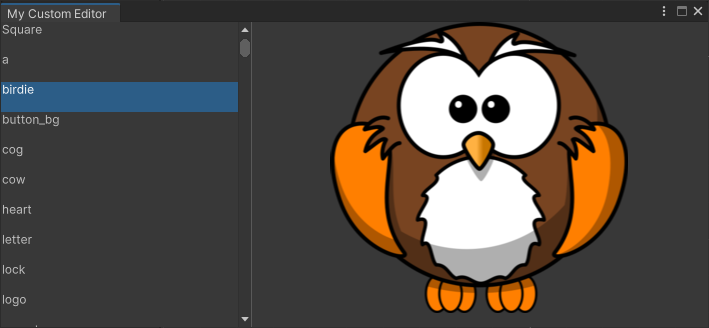
先决条件
This guide is for developers familiar with Unity, but new to UI Toolkit. It’s recommended to have a basic understanding of Unity and C# scripting.
This guide also references the following concepts:
Content
Controls used in this guide:
In this guide, you’ll do the following:
- Create the Editor window script.
- Create a menu entry to open the window.
- Add UI controls to the window.
- Write code to respond to user selections.
- Make the UI resizable.
- Support hot-reloading in the Editor.
Create the Editor window script
| Tip |
|---|
You can generate the necessary code to create an Editor window script in the Unity Editor. From the Project window, right-click and select Create > UI Toolkit > Editor Window. For this guide please disable the UXML and USS checkboxes. You might also have to add additional using directives at the top of the file, as shown below. |
You can create Editor windows through C# scripts in your project. A custom Editor window is a class that derives from the EditorWindow class.
Create a new script file MyCustomEditor.cs under the Assets/Editor folder. Paste the following code into the script:
using System.Collections.Generic;
using System.Linq;
using UnityEditor;
using UnityEngine;
using UnityEngine.UIElements;
public class MyCustomEditor : EditorWindow
{
}
| 注意 |
|---|
This is an Editor-only window that includes the UnityEditor namespace, so the file must be placed under the Editor folder, or inside an Editor-only Assembly Definition. |
创建一个菜单项来打开窗口
To open the new Editor window, you must create an entry in the Editor menu.
Add the MenuItem attribute to a static method. In this example, the name of the static method is ShowMyEditor().
Inside ShowMyEditor(), call the EditorWindow.GetWindow() method to create and display the window. It returns an EditorWindow object. To set the window title, change the EditorWindow.titleContent property.
Add the following function inside the MyCustomEditor class created in the previous step.
[MenuItem("Tools/My Custom Editor")]
public static void ShowMyEditor()
{
// 当用户在编辑器中选择菜单项时调用此方法
EditorWindow wnd = GetWindow<MyCustomEditor>();
wnd.titleContent = new GUIContent("My Custom Editor");
}
Test your new window by opening it via the Unity Editor menu Tools > My Custom Editor.
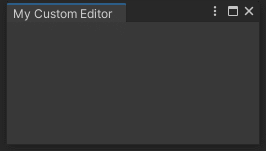
向窗口添加 UI 控件
UI Toolkit uses the CreateGUI method to add controls to Editor UI, and Unity calls the CreateGUI method automatically when the window needs to display. This method works the same way as methods such as Awake or Update.
You can add UI controls to the UI by adding visual elements to the visual tree. The VisualElement.Add() method is used to add children to an existing visual element. The visual tree of an Editor window is accessed via the rootvisualElement property.
To get started, add a CreateGUI() function to your custom Editor class and add a ‘Hello’ label:
public void CreateGUI()
{
rootVisualElement.Add(new Label("Hello"));
}
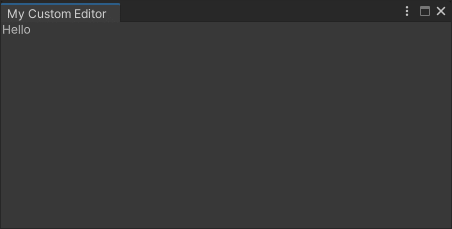
| 注意 |
|---|
To present a list of sprites, use AssetDatabase functions to find all sprites in a project. |
Replace the code inside CreateGUI() with the code below to enumerate all sprites inside the project.
public void CreateGUI()
{
// Get a list of all sprites in the project
var allObjectGuids = AssetDatabase.FindAssets("t:Sprite");
var allObjects = new List<Sprite>();
foreach (var guid in allObjectGuids)
{
allObjects.Add(AssetDatabase.LoadAssetAtPath<Sprite>(AssetDatabase.GUIDToAssetPath(guid)));
}
}
For the sprite browser, the top-level visual element will be a TwoPaneSplitView. This control splits the available window space into two panes: one fixed-size and one flexible-size. When you resize the window, only the flexible pane resizes, while the fixed-size pane remains the same size.
For the TwoPaneSplitView control to work, it needs to have exactly two children. Add code inside CreateGUI() to create a TwoPaneSplitview, then add two child elements as placeholders for different controls.
// 创建一个包含两个窗格的视图,左窗格固定
var splitView = new TwoPaneSplitView(0, 250, TwoPaneSplitViewOrientation.Horizontal);
// 通过将视图作为子元素添加到根元素来将视图添加到可视化树中
rootVisualElement.Add(splitView);
// 一个 TwoPaneSplitView 总是需要两个子元素
var leftPane = new VisualElement();
splitView.Add(leftPane);
var rightPane = new VisualElement();
splitView.Add(rightPane);
下图显示了带有两个空面板的自定义窗口。分割栏可以移动。
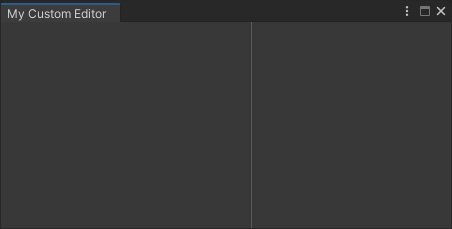
For the sprite browser, the left pane will be a list containing the names of all sprites found in the project. The ListView control derives from VisualElement, so it’s easy to modify the code to use a ListView instead of a blank VisualElement.
Modify the code inside the CreateGUI() function to create a ListView control for the left pane instead of a VisualElement.
public void CreateGUI()
{
...
var leftPane = new ListView();
splitView.Add(leftPane);
...
}
The ListView control displays a list of selectable items. It’s optimized to create only enough elements to cover the visible area, and pool and recycle the visual elements as you scroll the list. This optimizes performance and reduces the memory footprint, even in lists that have many items.
To take advantage of this, the ListView must be properly initialized with the following:
- An array of data items.
- A callback function to create an individual visual list entry in the list.
- A bind function that initializes a visual list entry with an item from the data array.
You can create complex UI structures for each element in the list, but this example uses a simple text label to display the sprite name.
Add code to the bottom CreateGUI() function that initializes the ListView.
public void CreateGUI()
{
...
// 使用所有精灵的名称初始化列表视图
leftPane.makeItem = () => new Label();
leftPane.bindItem = (item, index) => { (item as Label).text = allObjects[index].name; };
leftPane.itemsSource = allObjects;
}
The image below shows the Editor window with a scrollable list view and selectable items.
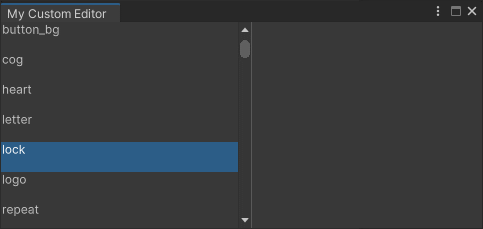
作为参考,以下是 CreateGUI() 函数的当前完整代码:
public void CreateGUI()
{
// Get a list of all sprites in the project
var allObjectGuids = AssetDatabase.FindAssets("t:Sprite");
var allObjects = new List<Sprite>();
foreach (var guid in allObjectGuids)
{
allObjects.Add(AssetDatabase.LoadAssetAtPath<Sprite>(AssetDatabase.GUIDToAssetPath(guid)));
}
// Create a two-pane view with the left pane being fixed with
var splitView = new TwoPaneSplitView(0, 250, TwoPaneSplitViewOrientation.Horizontal);
// Add the panel to the visual tree by adding it as a child to the root element
rootVisualElement.Add(splitView);
// A TwoPaneSplitView always needs exactly two child elements
var leftPane = new ListView();
splitView.Add(leftPane);
var rightPane = new VisualElement();
splitView.Add(rightPane);
// Initialize the list view with all sprites' names
leftPane.makeItem = () => new Label();
leftPane.bindItem = (item, index) => { (item as Label).text = allObjects[index].name; };
leftPane.itemsSource = allObjects;
}
Add callbacks
When you select a sprite from the list in the left pane, its image must display on the right pane. To do this you need to provide a callback function that the ListView can call when the user makes a selection. The ListView control has an onSelectionChange property for this purpose.
回调函数接收一个列表,其中包含用户选择的一个或多个项目。可以将 ListView 配置为允许多选,但默认情况下,选择模式仅限于单个项目。
Add a callback function when the user changes the selection from the list in the left pane.
public void CreateGUI()
{
...
// React to the user's selection
leftPane.onSelectionChange += OnSpriteSelectionChange;
}
private void OnSpriteSelectionChange(IEnumerable<object> selectedItems)
{
}
| 注意 |
|---|
| If you lose your window and the menu doesn’t reopen, close all floating panels through the menu under Window > Panels > Close all floating panels, or reset your window layout. |
To display the image of the selected sprite on the right side of the window, the function needs to be able to access the right-hand pane of the TwoPaneSplitView. You can make this control a member variable of the class to be able to access it inside the callback function.
Turn the rightPane created inside CreateGUI() into a member variable.
private VisualElement m_RightPane;
public void CreateGUI()
{
...
m_RightPane = new VisualElement();
splitView.Add(m_RightPane);
...
}
With a reference to the TwoPaneSplitView, you can access the right pane via the flexedPane property.
Before creating a new Image control on the right pane, use VisualElement.Clear() to remove the previous image. This method removes all children from an existing visual element.
Clear the right pane from all previous content and create a new Image control for the selected sprite.
private void OnSpriteSelectionChange(IEnumerable<object> selectedItems)
{
// 清除窗格中之前的全部内容
m_RightPane.Clear();
// 获取选定的精灵
var selectedSprite = selectedItems.First() as Sprite;
if (selectedSprite == null)
return;
// 添加一个新的 Image 控件并显示精灵
var spriteImage = new Image();
spriteImage.scaleMode = ScaleMode.ScaleToFit;
spriteImage.sprite = selectedSprite;
// 将 Image 控件添加到右窗格
m_RightPane.Add(spriteImage);
}
| 注意 |
|---|
Make sure to include using System.Linq; at the top of your file to use the First() method on the selectedItems parameter. |
Test your sprite browser in the Editor. The image below shows the custom Editor window in action.

使 UI 可调整大小
Editor windows are resizable within their minimum and maximum allowed dimensions. You can set these dimensions in C# when creating the window by writing to the EditorWindow.minSize and EditorWindow.maxSize properties. To prevent a window from resizing, assign the same dimension to both properties.
Limit the size of your custom editor window by adding the following lines to the bottom of the ShowMyEditor() function:
[MenuItem("Tools/My Custom Editor")]
public static void ShowMyEditor()
{
// 当用户在编辑器中选择菜单项时调用此方法
EditorWindow wnd = GetWindow<MyCustomEditor>();
wnd.titleContent = new GUIContent("My Custom Editor");
// 限制窗口的大小
wnd.minSize = new Vector2(450, 200);
wnd.maxSize = new Vector2(1920, 720);
}
For situations where the window dimensions are too small to display the entire UI, you must use a ScrollView element to provide scrolling for the window, or the content might become inaccessible.
The ListView on the left pane is using a ScrollView internally, but the right pane is a regular VisualElement. Changing this to a ScrollView control automatically displays scrollbars when the window is too small to fit the entire image in its original size.
Exchange the right pane VisualElement for a ScrollView with bidirectional scrolling.
public void CreateGUI()
{
...
m_RightPane = new ScrollView(ScrollViewMode.VerticalAndHorizontal);
splitView.Add(m_RightPane);
...
}
下图显示了带有滚动条的精灵浏览器窗口。
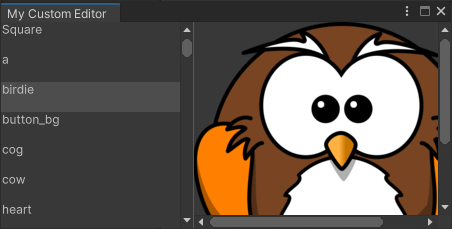
Close and reopen your custom Editor window to test out the new size limits.
| 注意 |
|---|
In Unity 2021.2 and up, Unity doesn’t respect the minSize and maxSize properties when the window is docked. This allows the user to resize dock areas without limitations. Consider creating a ScrollView as one of your top-level elements and place all UI inside of it to make your UI as responsive as possible. |
支持在编辑器中热重载
A proper Editor window must work with the hot-reloading workflow that happens in the Unity Editor. A C# domain reload occurs when scripts recompile or when the Editor enters Play mode. You can learn more about this topic on the Script Serialization page.
To see this in action in the Editor window you just created, open the sprite browser, select a sprite, and then enter Play mode. The window resets, and the selection disappears.
Since VisualElement objects aren’t serializable, the UI must be recreated every time a reload happens in Unity. This means that the CreateGUI() method is invoked after the reload has completed. This lets you restore the UI state before the reload by storing necessary data in your EditorWindow class.
Add a member variable to save the selected index in the sprite list.
public class MyCustomEditor : EditorWindow
{
[SerializeField] private int m_SelectedIndex = -1;
....
}
When you make a selection, the new selection index of the list view can be stored inside this member variable. You can restore the selection index during creation of the UI inside the CreateGUI() function.
Add code to the end of the CreateGUI() function to store and restore the selected list index.
public void CreateGUI()
{
...
// 恢复热重载前的选择索引
leftPane.selectedIndex = m_SelectedIndex;
// 选择更改时存储选择索引
leftPane.onSelectionChange += (items) => { m_SelectedIndex = leftPane.selectedIndex; };
}
Select a sprite from the list and enter Play mode to test hot-reloading.
Editor window script
The code below is the final script of the Editor window created during this guide. You can paste the code directly into a file called MyCustomEditor.cs inside the Assets/Editor folder to see it in the Unity Editor.
using System.Collections.Generic;
using System.Linq;
using UnityEditor;
using UnityEngine;
using UnityEngine.UIElements;
public class MyCustomEditor : EditorWindow
{
[SerializeField] private int m_SelectedIndex = -1;
private VisualElement m_RightPane;
[MenuItem("Tools/My Custom Editor")]
public static void ShowMyEditor()
{
// This method is called when the user selects the menu item in the Editor
EditorWindow wnd = GetWindow<MyCustomEditor>();
wnd.titleContent = new GUIContent("My Custom Editor");
// Limit size of the window
wnd.minSize = new Vector2(450, 200);
wnd.maxSize = new Vector2(1920, 720);
}
public void CreateGUI()
{
// Get a list of all sprites in the project
var allObjectGuids = AssetDatabase.FindAssets("t:Sprite");
var allObjects = new List<Sprite>();
foreach (var guid in allObjectGuids)
{
allObjects.Add(AssetDatabase.LoadAssetAtPath<Sprite>(AssetDatabase.GUIDToAssetPath(guid)));
}
// Create a two-pane view with the left pane being fixed with
var splitView = new TwoPaneSplitView(0, 250, TwoPaneSplitViewOrientation.Horizontal);
// Add the panel to the visual tree by adding it as a child to the root element
rootVisualElement.Add(splitView);
// A TwoPaneSplitView always needs exactly two child elements
var leftPane = new ListView();
splitView.Add(leftPane);
m_RightPane = new ScrollView(ScrollViewMode.VerticalAndHorizontal);
splitView.Add(m_RightPane);
// Initialize the list view with all sprites' names
leftPane.makeItem = () => new Label();
leftPane.bindItem = (item, index) => { (item as Label).text = allObjects[index].name; };
leftPane.itemsSource = allObjects;
// React to the user's selection
leftPane.onSelectionChange += OnSpriteSelectionChange;
// Restore the selection index from before the hot reload
leftPane.selectedIndex = m_SelectedIndex;
// Store the selection index when the selection changes
leftPane.onSelectionChange += (items) => { m_SelectedIndex = leftPane.selectedIndex; };
}
private void OnSpriteSelectionChange(IEnumerable<object> selectedItems)
{
// Clear all previous content from the pane
m_RightPane.Clear();
// Get the selected sprite
var selectedSprite = selectedItems.First() as Sprite;
if (selectedSprite == null)
return;
// Add a new Image control and display the sprite
var spriteImage = new Image();
spriteImage.scaleMode = ScaleMode.ScaleToFit;
spriteImage.sprite = selectedSprite;
// Add the Image control to the right-hand pane
m_RightPane.Add(spriteImage);
}
}
Did you find this page useful? Please give it a rating:
Thanks for rating this page!
What kind of problem would you like to report?
Thanks for letting us know! This page has been marked for review based on your feedback.
If you have time, you can provide more information to help us fix the problem faster.
Provide more information
You've told us this page needs code samples. If you'd like to help us further, you could provide a code sample, or tell us about what kind of code sample you'd like to see:
You've told us there are code samples on this page which don't work. If you know how to fix it, or have something better we could use instead, please let us know:
You've told us there is information missing from this page. Please tell us more about what's missing:
You've told us there is incorrect information on this page. If you know what we should change to make it correct, please tell us:
You've told us this page has unclear or confusing information. Please tell us more about what you found unclear or confusing, or let us know how we could make it clearer:
You've told us there is a spelling or grammar error on this page. Please tell us what's wrong:
You've told us this page has a problem. Please tell us more about what's wrong:
Thank you for helping to make the Unity documentation better!
Your feedback has been submitted as a ticket for our documentation team to review.
We are not able to reply to every ticket submitted.